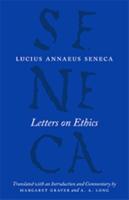
Chicago (2015) h/b 604pp £65.00 (ISBN 139780226265179)
Philosophical tracts can be forbidding and unappealing, and many philosophers have over the centuries looked for way to sweeten the pill, whether by writing in verse (as did Lucretius, Manilius, Horace and others) or else by composing dramatic dialogues as did Plato and Cicero. The idea of composing literary or philosophical letters was an extension of the dialogue, where we have one side of a conversation and where there is often a context of real life, with gossip and small talk mingled in with heavy thinking. Horace of course composed his Epistles in verse, but Plato had also composed Letters (some of them possibly spurious) and the letters of Epicurus are vital for our knowledge of his philosophy; and the form went on to influence the essays of Plutarch and Montaigne.
Seneca could do the grand style like nobody else in town when he was writing tragedy; but these letters show his command of the quieter conversational tone which at times is closer to satire than it is to epic or logic. His range of topics goes from the sublime to the commonplace—from systematic philosophy to the evils of drunkenness—but it is all concerned with the fundamental ethical question of how we ought to live our lives both in obviously philosophical terms (such as out attitude towards our death) and in less philosophical terms (such as our attitudes towards our slaves).
‘Our aim as translators is to convey Seneca’s ideas exactly while also giving some sense of his ever-changing mood and style’ (p. 24). This double objective, to serve Seneca both as a thinker and also as a writer of wonderful Latin prose, is a tall order, and one any translation would struggle to fulfil, but G.-L. are a great leap forward on previous attempts in this regard.
Look for instance at Letter 30, where Seneca is discussing Aufidius Bassus, a wise elderly man whose Epicurean attitude towards the fear of death is one which the Stoic Seneca nonetheless cites with some approval. One rather philosophical paragraph (30.6) reads:
Tam demens autem est qui timet quod non est passurus quam qui timet quod non est sensurus. an quisquam hoc futurum credit, ut per quam nihil sentiatur, ea sentiatur? ‘ergo’ inquit, ‘mors adeo extra omne malum est ut sit extra omnem malorum metum’.
Here is G.-L.’s version:
‘A person would be crazy to fear something that’s not going to happen to him, and it is equally crazy to fear something you won’t feel. Or does anyone believe that he will feel death, when in fact it is through death that he ceases to feel anything else? “For that reason” he says “death is so far removed from every evil that it is beyond every fear of evil.”’
The thinking is clear—not slavishly close to the Latin but good at conveying what the man is saying. The emphasis which Seneca gives by the repetition sentiatur..sentiatur is conveyed and where Seneca repeats other words (such as malum … malorum) they do too. Now look at a more conversational passage, where the routine infirmities of old age are compared to a leaking ship and a crumbling house (30. 2):
Quemadmodum in naue quae sentinam trahit uni rimae aut alteri obsistitur, ubi plurimis locis laxari coepit et cedere, succurri non potest nauigio dehiscenti, ita in senile corpore aliquatenus imbecillitas sustineri et fulciri potest. ubi tamquam in putri aedificio omnis iunctura diducitur et dum alia excipitur, alia discinditur, circumspiciendum est quomodo exeas.
The lengthy paragraph, made up of two sentences, is clear but by no means simple and G.-L. wisely break it up with a lot of punctuation as follows, moving the sentence break altogether and creating a real sense of conversational tone which keeps the ideas flowing but lets fresh air into the complex phrasing:
‘It’s like when a boat takes on water: you stop up one leak, then another; but once it begins to open up and give way at many places, there’s no way to fix it; it’s just a leaky vessel. So it is with an aging body. Stop-gap measures can sustain it for a while, but when every joint is giving way like the seams of a dilapidated house, when you cannot take care of one thing without something else giving out in the meanwhile, then it is time to look round for the exit.’
Where Seneca is colloquial, G.-L. usually follow suit. quo genere? in 54.1, for instance, is translated ‘what was the trouble?’. When Seneca quotes Greek, G.-L. put it naturally into English, but in quotes: where Seneca quotes poetry they translate it into a neat form of English verse (see e.g. 85.4, quoting four lines of Virgil).
There is a general introduction on ‘Seneca and his World’ (by a very impressive team of Elizabeth Asmis, Shadi Bartsch and Martha Nussbaum) which is authoritative and clear, and G.-L. have written their own separate introduction to these letters with more specific explanation of Seneca’s attitude towards politics and literature as well as his attitude to philosophy. The letters, in this elegant and readable translation, speak for themselves, but G.-L. have also given us brief notes at the back of the book to explain things which the general reader would need explaining, whether it be the philosophical references or the domestic details of Roman life (such as the wax masks of ancestors in a Roman atrium at 44.5).
The book is impeccably proof-read and beautifully printed and presented. I hope that a paperback edition will come out soon to make this excellent book more affordable. The Stoic ideas are as relevant now as they were in the days of the emperor Nero and G.-L. have done Seneca (and us) a great service in making the old man speak so clearly once again.
Dr John Godwin
